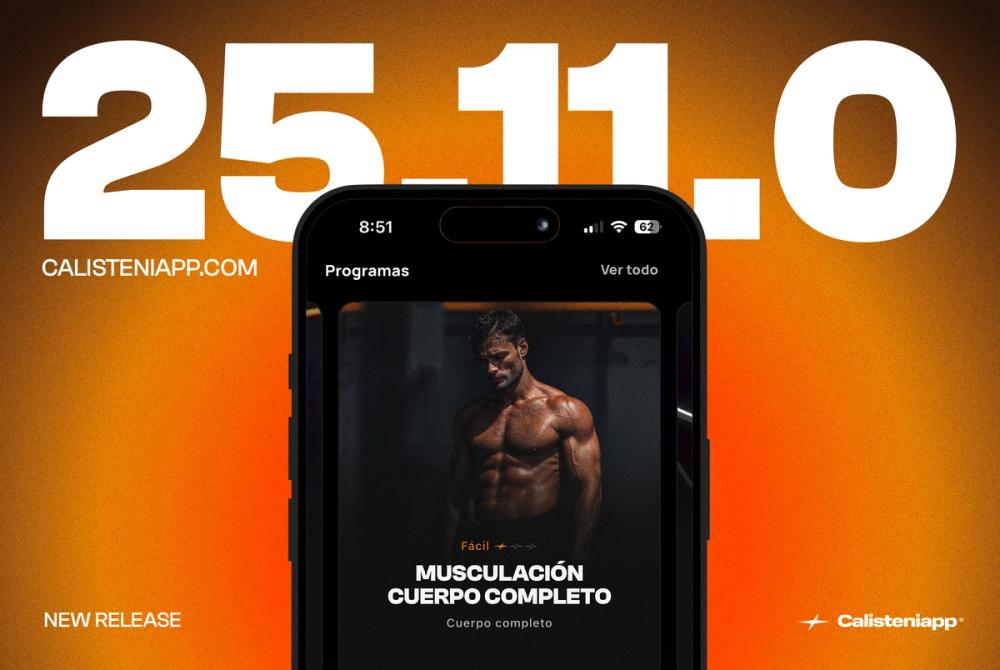
Release 25.11.0 - A new beginning
Calisteniapp is a symbol that represents our obsession with excellence, our essence, and the path we want to define for the next ten years.

After recently talking about technique in weighted dips and the extended range in calisthenics exercises, the topic of whether some exercises are “harmful” or not has come up quite frequently.
It’s true that on social media, in the street, or at the gym, there seems to be an intense, uncontrollable, overwhelming need to say “that exercise is harmful” at the slightest opportunity.
From the point of view of someone like me, who posts training content on social media, every time I post something showing an exercise that could possibly prompt that comment—or someone doing some epic feat—I know with 100% certainty someone will post a warning. It’s as if there’s a fire and this person thinks no one has noticed, so they need to warn everyone before something serious happens.
It always makes me laugh when these are videos of people who have trained for years and fought hard to master a specific exercise or skill—achieving almost superhuman feats—only to get the typical comment: “If you keep doing that... you’ll end up injured.” I picture the person in the video reading that and saying, “WOW! I hadn’t realized! Good thing you just warned me—I was planning to keep doing this thing I’m passionate about and have sacrificed so much for, but now, thanks to your warning, I’m going to quit and get a job as an accountant in an office. Thank you for saving me!”

That brings me to what I really wanted to talk about today: are there truly harmful exercises? Should we take these opportunistic warnings seriously? What about exercises like behind-the-neck pull-ups, deep range dips, pistol squats, Korean dips, deadlifts, and the like?
The first truth I think we need to acknowledge is that some exercises, all else being equal, are more prone to causing injury. It doesn’t matter if you’re using the right intensity for your level or if you’re using perfect technique—these exercises statistically have a higher chance of causing injury compared to the average exercise.
For example, you're more likely to get injured doing behind-the-neck pull-ups than standard pull-ups. This is simply because that position is more compromising for your shoulder and neck joints. Even with good shoulder mobility, careful execution, and appropriate intensity, it places the joint in a position where injury is more likely.
A clear and common example in calisthenics is the supinated grip back lever, which many athletes use when training for the Hefesto, advanced ring skills, and so on. Over the years, these exercises have led to a notable number of biceps tears in well-known athletes, social media creators, and even top-level global competitors.

If there weren’t exercises more prone to causing injury, why are so many people getting injured in exactly the same way? Why with these specific exercises and not others? Some of these athletes are the best prepared, those who plan their training meticulously and take the greatest care with their joints—and yet, they all fall the same way.
The truth is that exercises involving this particular position place the biceps in a very vulnerable, fully stretched state under high tension—making injuries more likely. That’s why you’re more likely to get injured with a supinated back lever than with a pronated one, since with the latter, the arm’s rotation reduces biceps vulnerability.
The same goes for other exercises that tend to trigger warnings in the comments: extended range exercises, deadlifts, behind-the-neck pull-ups, etc. Yes, these have a higher injury probability than traditional movements—but that leads us to the next key point.
Even if an exercise is more prone to causing injury, you can mitigate the risk in several ways:
Yes, the guy doing front levers on his pinkies or ultra-deep handstand push-ups on Instagram is definitely pushing his joints, but it’s also true that he’s likely trained for months or years to do that—so he’s already done a lot to reduce his injury risk.
By combining these factors, you can turn a potentially dangerous exercise into a safe one.

Given all this, the key question becomes: why use these exercises at all? If you know a variation has a higher injury risk, why choose it?
I think you need to seriously evaluate this and only use one of these exercises if there’s no better option. Let’s look at a few examples:
As for behind-the-neck pull-ups, I don’t see any compelling reason to use them. They don’t offer anything significantly different from standard pull-ups. So if you choose to do them, it’s purely subjective—and you’ll have to accept the risk. But they’re not advisable.
Some exercises, by their nature, have a greater tendency to cause injuries. But if you need to use them, taking the right precautions can help you offset that risk and incorporate them safely into your training.
If you want a well-structured training program with safe exercises and injury prevention in mind, I recommend checking out the ones we offer in Calisteniapp.
By Yerai Alonso

Yerai Alonso
Cofundador de Calisteniapp, referente en calistenia y el street workout en Español. Con más de una década de experiencia, es creador de uno de los canales de YouTube más influyentes del sector. Autor del libro La calle es tu gimnasio, campeón de Canarias y jurado en competiciones nacionales e internacionales.
Join our newsletter
Learn everything you need to know about calisthenics

Calisteniapp is a symbol that represents our obsession with excellence, our essence, and the path we want to define for the next ten years.

Descubre los mejores ejercicios de antebrazo para calistenia. Mejora fuerza, agarre y control corporal con entrenamientos efectivos sin pesas.

Discover the 20 most effective ab exercises to train and strengthen your core through calisthenics.
